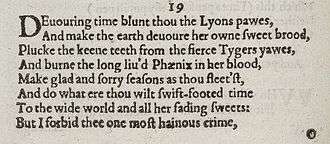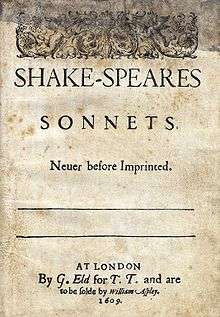Sonnet 19
| Sonnet 19 | |||||||
|---|---|---|---|---|---|---|---|
 The first two stanzas of Sonnet 19 in the 1609 Quarto | |||||||
|
| |||||||
| |||||||
Sonnet 19 is one of 154 sonnets written by the English playwright and poet William Shakespeare and is considered by some to be the final sonnet of the initial procreation sequence. The sonnet addresses time directly with the instruction to destroy its own weapons and to leave Shakespeare's beloved, the fair youth, unscathed. The theme is redemption, through art, of time's inevitable decay.
Structure
Sonnet 19 is a typical English or Shakespearean sonnet. The English sonnet consists of three quatrains followed by a couplet. It follows the form's typical rhyme scheme: abab cdcd efef gg. Like all but one of Shakespeare's sonnets, Sonnet 19 is written in a type of metre called iambic pentameter based on five pairs of metrically weak/strong syllabic positions. The eighth line exemplifies a regular iambic pentameter:
× / × / × / × / × / But I forbid thee one most heinous crime: (19.8)
- / = ictus, a metrically strong syllabic position. × = nonictus.
Both the first and third lines exhibit reversals which thrust extra emphasis on an action verb, a practice Marina Tarlinskaja calls rhythmical italics[2]
(line three also exhibits an ictus moved to the right, resulting in a four-position figure, × × / /, sometimes referred to as a minor ionic):
× / × / / × × /× / Devouring Time, blunt thou the lion's paws, (19.1) / × × / × × / / × / Pluck the keen teeth from the fierce tiger's jaws, (19.3)
Synopsis and analysis
Sonnet 19 addresses time directly as "Devouring Time", a translation of the often-used phrase from Ovid, "tempus edax" (Met. 15.258).[3] G. Wilson Knight notes and analyzes the way in which devouring time is developed by trope in the first 19 sonnets. Jonathan Hart notes the reliance of Shakespeare's treatment on tropes from not only Ovid but also Edmund Spenser.
The sonnet consists of a series of imperatives, where time is commanded to disempower its own instruments: it must "blunt ... the lion's paws;" it must force mother earth ("her") to "devour" her children ("own sweet brood"). Time is ordered to pull ("pluck") the tiger's "keen teeth", its 'eager', its 'sharp', and its 'fierce' teeth from the jaw of a tiger. The quarto's "yawes" was amended to "jaws" by Edward Capell and Edmond Malone; this change is now almost universally accepted.
Fourthly, and impossibly, time is required to "burn the long-liv'd phoenix, in her blood." The phoenix is a long-lived bird that is cyclically regenerated or reborn. Associated with the sun, a phoenix obtains new life by arising from the ashes of its predecessor. George Steevens glosses "in her blood" as "burned alive" by analogy with Coriolanus (4.6.85); Nicolaus Delius has the phrase "while still standing."
As time speeds by ("fleet'st", although variations in early modern spelling allow "flee'st" as in 'time flies' or 'tempus fugit'), it must vary the seasons ("make glad and sorry seasons"), which are not only cycles of nature but ups and downs of human moods. The penultimate command verges on the careless or dismissive: "do what ere thou wilt." The epithet "swift-footed time" was commonplace, as was "the wide world".[3]
Finally the poet denies time a singular, most grievous sin ("one most hainous crime"). It must "carve not with thy hours my love's fair brow". In associating crime and wrinkles Shakespeare has drawn on Ovid again, "de rugis crimina multa cadunt" ('from wrinkles many crimes are exposed' from Amores 1.8.46), rendered by Christopher Marlowe as "wrinckles in beauty is a grieuous fault".[3] The hours must not etch into the beloved's brow any wrinkle (compare Sonnet 63, "When hours have .. fill'd his brow / With lines and wrinkles"). Nor must time's "antique pen," both its 'ancient' and its 'antic' or crazy pen, "draw ... lines there".[3]
Time must allow the youth to remain "untainted" in its "course"; one meaning of "untainted" (from tangere = to touch) is 'untouched' or 'unaffected' by the course of time. The couplet dismisses time's efforts ("Yet do thy worst old Time"). Whatever injuries or faults ("wrongs") time might commit, the poet's "love," both his affection and the beloved, will prevail in the poet's lines ("verse") as ever fresh and never growing old ("ever live young"). Henry Charles Beeching perceives a valediction in the final line, meant to indicate that the opening group of sonnets ends here.
Interpretations
In Gustav Holst's opera, At the Boar's Head, the sonnet is performed as a song sung by Prince Hal in disguise as entertainment for Falstaff and Doll Tearsheet.
David Harewood reads it for the 2002 compilation album, When Love Speaks (EMI Classics)
References
- ↑ Pooler, C[harles] Knox, ed. (1918). The Works of Shakespeare: Sonnets. The Arden Shakespeare [1st series]. London: Methuen & Company. OCLC 4770201.
- ↑ Tarlinskaja, Marina (2014). Shakespeare and the Versification of English Drama, 1561–1642. Farnham: Ashgate. pp. 29–32. ISBN 978-1-4724-3028-1.
- 1 2 3 4 Larsen, Kenneth J. "Sonnet 19". Essays on Shakespeare's Sonnets. Retrieved 28 November 2014.
Further reading
- Baldwin, T. W. (1950). On the Literary Genetics of Shakspeare's Sonnets. University of Illinois Press, Urbana.
- Hart, Jonathan (2002). "Conflicting Monuments." In the Company of Shakespeare. AUP, New York.
- Hubler, Edwin (1952). The Sense of Shakespeare's Sonnets. Princeton University Press, Princeton.
- Schoenfeldt, Michael (2007). The Sonnets: The Cambridge Companion to Shakespeare's Poetry. Patrick Cheney, Cambridge University Press, Cambridge.
- First edition and facsimile
- Shakespeare, William (1609). Shake-speares Sonnets: Never Before Imprinted. London: Thomas Thorpe.
- Lee, Sidney, ed. (1905). Shakespeares Sonnets: Being a reproduction in facsimile of the first edition. Oxford: Clarendon Press. OCLC 458829162.
- Variorum editions
- Alden, Raymond Macdonald, ed. (1916). The Sonnets of Shakespeare. Boston: Houghton Mifflin Company. OCLC 234756.
- Rollins, Hyder Edward, ed. (1944). A New Variorum Edition of Shakespeare: The Sonnets [2 Volumes]. Philadelphia: J. B. Lippincott & Co. OCLC 6028485.
- Modern critical editions
- Atkins, Carl D., ed. (2007). Shakespeare's Sonnets: With Three Hundred Years of Commentary. Madison: Fairleigh Dickinson University Press. ISBN 978-0-8386-4163-7. OCLC 86090499.
- Booth, Stephen, ed. (2000) [1st ed. 1977]. Shakespeare's Sonnets (Rev. ed.). New Haven: Yale Nota Bene. ISBN 0-300-01959-9. OCLC 2968040.
- Burrow, Colin, ed. (2002). The Complete Sonnets and Poems. The Oxford Shakespeare. Oxford: Oxford University Press. ISBN 978-0192819338. OCLC 48532938.
- Duncan-Jones, Katherine, ed. (2010) [1st ed. 1997]. Shakespeare's Sonnets. The Arden Shakespeare, Third Series (Rev. ed.). London: Bloomsbury. ISBN 978-1-4080-1797-5. OCLC 755065951.
- Evans, G. Blakemore, ed. (1996). The Sonnets. The New Cambridge Shakespeare. Cambridge: Cambridge University Press. ISBN 978-0521294034. OCLC 32272082.
- Kerrigan, John, ed. (1995) [1st ed. 1986]. The Sonnets ; and, A Lover's Complaint. New Penguin Shakespeare (Rev. ed.). Penguin Books. ISBN 0-14-070732-8. OCLC 15018446.
- Mowat, Barbara A.; Werstine, Paul, eds. (2006). Shakespeare's Sonnets & Poems. Folger Shakespeare Library. New York: Washington Square Press. ISBN 978-0743273282. OCLC 64594469.
- Orgel, Stephen, ed. (2001). The Sonnets. The Pelican Shakespeare (Rev. ed.). New York: Penguin Books. ISBN 978-0140714531. OCLC 46683809.
- Vendler, Helen, ed. (1997). The Art of Shakespeare's Sonnets. Cambridge, MA: The Belknap Press of Harvard University Press. ISBN 0-674-63712-7. OCLC 36806589.
External links
 Works related to Sonnet_19_(Shakespeare) at Wikisource
Works related to Sonnet_19_(Shakespeare) at Wikisource- Paraphrase and analysis (Shakespeare-online)
- Analysis
.png)
